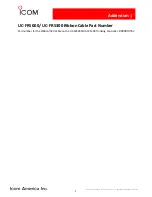
© MHG Heating Ltd
11
MHG Heating Ltd, Unit 4 Epsom Downs Metro Centre, Waterfield, Tadworth, Surrey, KT20 5LR
Phone 0845 6448802 Telephone. 0845 6448803 Fax. Email
Website www.mhgheating.co.uk
010313
Draft
Worked Example
The example below is for a G
1
/
2
temperature relief valve with a discharge pipe (D2) having 4 no. elbows and length of 7m from the tundish to the point of discharge.
From Table 1
Maximum resistance allowed for a straight length of 22mm copper discharge pipe (D2) from a G
1
/
2
temperature relief valve is: 9.0m. Subtract the resistance for 4 No. 22mm elbows at
0.8m each = 3.2m
Therefore the maximum permitted length equates to: 5.8m
5.8m is less than the actual length of 7m therefore calculate the next largest size.
Maximum resistance allowed for a straight length of 28mm pipe (D2) from G1/2 temperature relief valve equates to: 18m.
Subtract the resistance for 4 No. 28mm elbows at 1.0m each = 4m.
Therefore the maximum permitted length equates to 14m.
As the actual length is 7m, a 28mm (D2) copper pipe will be satisfactory.
NOTES ON WATER QUALITY AND SCALING
Water hardness can vary considerably around the country. If furring of kettles normally occurs in the area, then the unit should be fed with
conditioned water only. This can be provided by a water softener with a high capacity flow rate, or a suitable water conditioner (not supplied).
It is recommended that the temperature controls are set below 65
0
C to prevent lime scale build up.
The performance of all water storage appliances and their associated components may deteriorate if you do not protect adequately against
hard water scaling. If more than 150ppm salts are present in local water samples, an effective conditioner should always be used.
Maintenance
The following checks should be conducted annually:
Check the operation of the T & P valve and Expansion valve by rotating the heads of the valves in turn until water is discharged. The
discharge should stop immediately when the valve head is released. Should this not be the case the valve should be replaced. Check that the
discharged water flows freely to waste and that there is no blockage.
Remove and clean the filter in the Pressure Reducing Valve.
Check that the expansion vessel charge pressure is set at 0.2 bar below the incoming pressure. If water is being discharged from the expansion
valve it may be indicative of pressure loss within the expansion vessel itself. To check the pressure, isolate the unit from the cold supply and
release any pressure by opening a hot tap until water stops flowing. Then use a tyre pressure gauge to verify the charge pressure. If the unit is
more than 5 years old when this problem is experienced it may be advisable to replace the pressure vessel. If however, the pressure in the
expansion vessel is 0.2 bar below incoming pressure the discharge may be being caused by back pressure or cross-over between the cold and
hot water supplies - see below.
To replace the pressure vessel, unscrew from threaded connection. The new pressure vessel should be adjusted to 0.2 bar below incoming
pressure and then fitted to the cylinder, ensuring that the threads are sealed appropriately.

































